WebRTC guide
WebRTC is used to establish peer-to-peer (p2p) connection between 2 browsers. On the surface, if you have ever used WebSockets, you might not think much about p2p. WebSockets are banal, what could be so complicated in p2p? But riddle me this: how does one host know the IP of the other host? How would the connection change if both users were on the same network? And what if they are on different continents? How do you handle mobile users switching between the networks? Many mechanisms from the familiar client-server model do not have a corresponding term in peer-to-peer.
Let’s dive into a world of STUN and TURN servers. Let’s look at the flow of the ICE protocol. A lot of what you will see should bring back some magic into the old boring request sending. You can find the complete code on my GitHub: WebRTC-p2p-text-chat.
Finding the peer
We start from a blank slate. Neither peer knows about the other. The only thing in common - they want to use our app to exchange data. The final connection will be peer-to-peer. Our role is to facilitate the direct transmission between them.
Let’s look through a few tools used to enable unmediated connection between 2 peers on the internet.
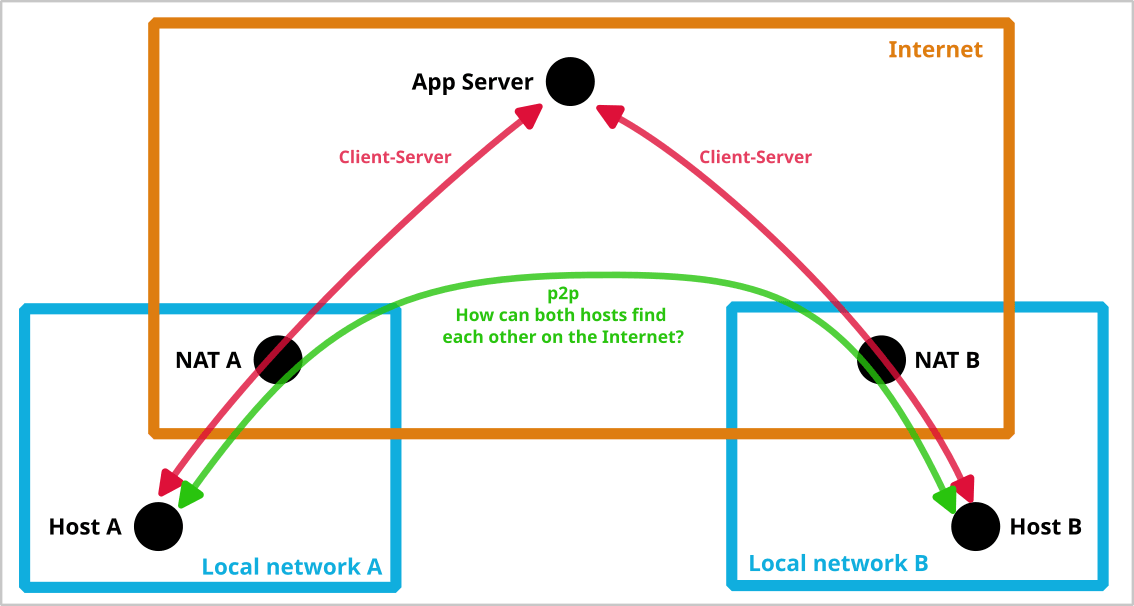
Finding a peer on the Internet could be challenging. We can’t just exchange addresses and expect things to work.
STUN server - Session Traversal Utilities for NAT
Specification: RFC 5389 or newer RFC 8489
The basic question when using WebRTC is: “How do I find the other user?“. If we asked them for their IP, they would respond with something like 10.0.0.1. But this is only their IP inside a private network. To send a packet to them we need their internet-facing IP (and also a port and protocol). This packet would reach their router (under the internet-facing IP), which in turn would use some extra data to forward the package to the final device. This is known as network address translation (NAT).
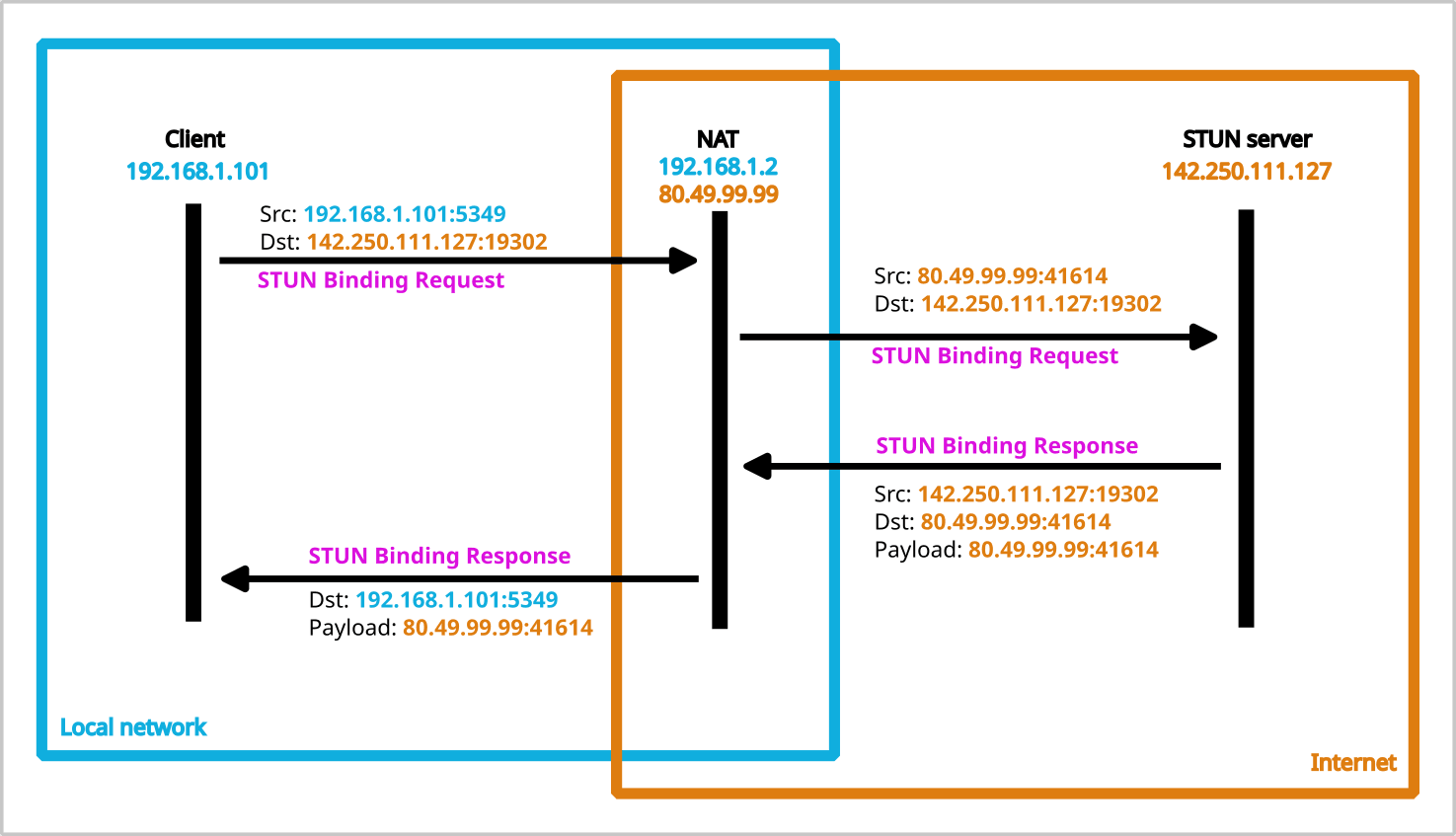
Simple flow of requests to STUN server. It notes what was the address of the request source and puts it into a response.
Providing internet-facing addresses (IP, port) for clients is a role of STUN servers. There are even a few public STUN servers that we can use for free. You can test it for yourself using https://webrtc.github.io/samples/src/content/peerconnection/trickle-ice/. Add stun:stun.l.google.com:19302 and stun:openrelay.metered.ca:80 then click “Gather candidates”. Entries with type srflx will contain your public IP.
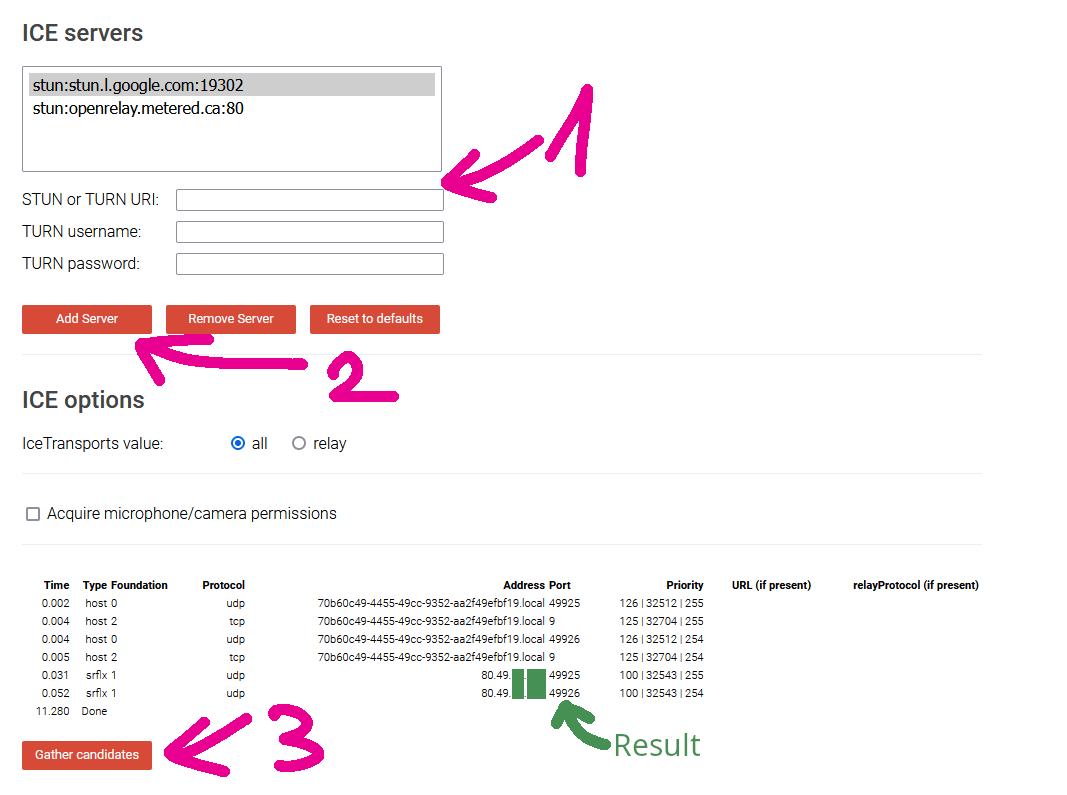
Testing STUN and TURN servers using the “WebRTC samples Trickle ICE” tool.
Peer-to-peer is also used for the BitTorrent protocol. Popular site iknowwhatyoudownload.com reports recent torrent files requested by your public IP.
Once we know our public address, we can share it with other users. This solution is simple, low-maintenance, and not always reliable. With certain network architectures and NAT devices, you will need TURN servers and ICE. This often happens for symmetric NAT. In that case, the internet-facing port changes based on the packet destination (different for STUN server and peer connection).
TURN server - Traversal Using Relays around NAT
Specification: RFC 5766
Traversal Using Relays around NAT (TURN) server acts as an intermediary between 2 peers. If we cannot reach the 2nd device, we can send the data to the known 3rd party that forwards the packets for us. All that’s needed is for both peers to agree on this method. We will see the negotiation process when discussing the ICE protocol. As you can imagine, this procedure is much more complicated than a STUN server. Very often both STUN and TURN servers are running on the same machine.
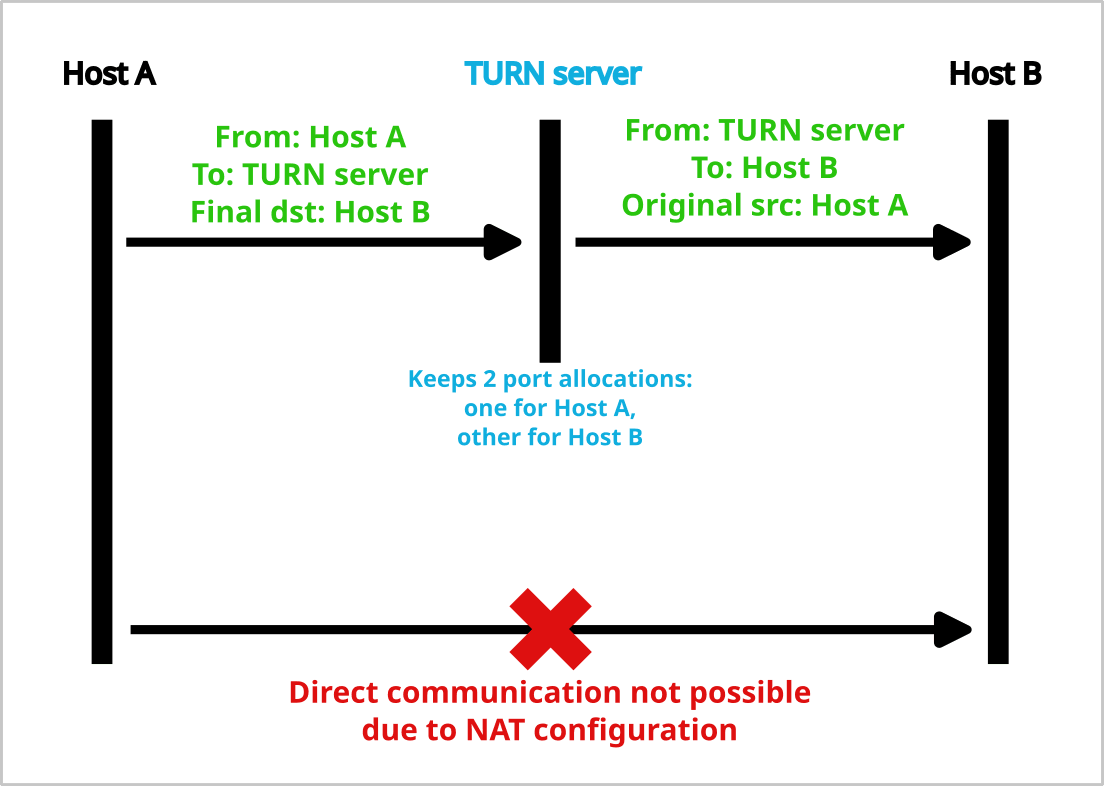
TURN servers are used when direct communication between peers is not possible.
TURN servers usually offer UDP, TCP, and TLS protocols. While in WebRTC you can provide addresses for many TURN servers, usually you will only provide 3 entries to the same server - one for each protocol. It is possible to select the physically closest server based on the geolocation of 2 peers.
There is a lot of traffic going through the TURN server. It’s not cheap. You will not find one for free. Or rather, you do not want to use one that is free. For simple tests, Open Relay might be enough. In production, your choice is between using a managed Communications Platform-as-a-Service (CPaaS) or rolling your own. Popular open-source implementations are coturn and Janus.
If possible, we want to avoid resorting to TURN servers during the connections. Often, the address retrieved from the STUN server will just work. And sometimes we can even use local addresses if devices are on the same network. This is where the Interactive Connectivity Establishment (ICE) comes in.
ICE - Interactive Connectivity Establishment
Specification: RFC 5245
It’s not that kind of ICE.
To establish the connection, ICE will create a list of possible/candidate addresses:
- Using local interface (
HOST CANDIDATE). This solution includes e.g. Ethernet, WiFi, or VPN. Creates candidate per IP address in case the host is multihomed. SERVER REFLEXIVE CANDIDATESbased on the information from STUN servers.RELAYED CANDIDATESthat use TURN servers.PEER REFLEXIVE CANDIDATESare actually generated later during the ICE process for specific NAT configurations (e.g. symmetric NAT).
Device A will then send the list to the device B. This is an offer. Device B will then create its own candidate’s list (an answer) and send it to device A. You may ask, how is the list transmitted, if we have yet to establish a peer-to-peer connection? We have to do it using other means than p2p. Usually, both clients open a socket connection to your app’s server. These connections are then used as the intermediary for the offer-answer exchange. The lists are encoded using the Session Description Protocol (SDP) text protocol. This way, each device has a list of both its candidates and its peer’s candidates. CANDIDATE PAIRS are created, sorted by priority, and checked. Both devices A and B will send and confirm each pair. For a pair to pass the check, it requires 4 successful transmissions:
- Pair checked by Device A:
- (1) Device A sends a request to Device B
- (2) Device B responds to Device A
- The same pair checked by Device B:
- (3) Device B sends a request to Device A
- (4) Device A responds to Device B
One of the devices is nominated as a CONTROLLING AGENT and the other as a CONTROLLED AGENT. The CONTROLLING AGENT gets to decide which CANDIDATE PAIR that passed the check is selected as a communication method. It can even end the process early.
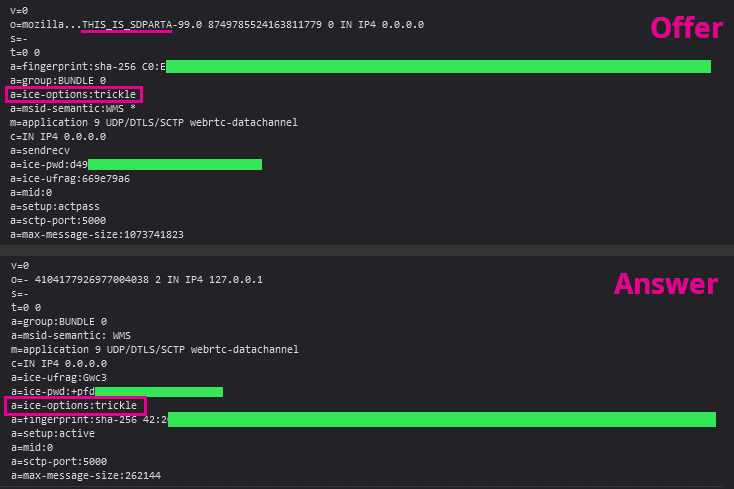
Examples of ICE offer and answer in Firefox. ICE specification describes the grammar for both. Offer and answer can contain candidate attributes, but in this case, trickle ICE is used.
This whole process might take a while. There exists Trickle ICE that does not wait to collect all candidates beforehand. New candidates are exchanged as they are discovered. Useful when waiting for the initial STUN/TURN server response.
I recommend Tsahi Levent-Levi’s “We TURNed to see a STUNning view of the ICE” as a useful list of guidelines. Use https://webrtc.github.io/samples/src/content/peerconnection/trickle-ice/ for tests. Of course, if you have 2 devices on the same local network, the ICE will select HOST CANDIDATE. Remember to check that UDP, TCP, and TLS are configured correctly on the TURN server. ICE tends to prefer UDP, which is often blocked on firewalls. Disable UDP during testing.
WebRTC flow in web browsers
Let’s look at how a sample flow looks for a simple peer-to-peer text chat room. While WebRTC is used for more advanced scenarios than text messages, you will have to implement this functionality too. Concepts like ‘chat room’ are too universal in multi-user usages.
When creating the new chatroom:
- User A establishes a socket connection with the socket server.
userId_Ais generated. - User A sends a
create-roomsocket message. - The socket server responds to User A with
room-created(roomId). - User A sends
roomId(or a fancy ‘join me’ link) to someone by email or SMS, etc. - User A waits for someone to join so it can establish a WebRTC connection with them.
After some time, User B will want to join User A:
- User B clicks on the ‘join me’ link from User A’s email/SMS.
- User B establishes a socket connection with the socket server.
userId_Bis generated. - User B sends a
join-room(roomId)socket message. - The socket server sends a message to User A:
new-user-joined(userId_B). This message is broadcast to all other users in the chat room too. - User A starts the ICE flow to establish the peer-to-peer connection with User B:
- User A creates an RTCPeerConnection object providing a list of STUN and/or TURN server URLs. Each URL will be used to create ICE candidates. You should also set an icecandidate event handler for when the ICE finds a suitable transport method.
- User A creates a data channel for text messages. If you call
createDataChannel()later, it will trigger renegotiation. The peer that creates an offer is usually one that creates a data channel. - User A creates an
offerusing RTCPeerConnection: createOffer() method. It sets it as a localDescription. - User A sends a
rtc-offer(userId_B, offer)socket message to the socket server.
- Socket server forwards offer message to User B:
rtc-offer(userId_A, offer). - User B receives the
rtc-offer(userId_A, offer)from the socket server. It creates an ICE answer and sends it (through the socket server) to User A:- User B creates an RTCPeerConnection object like how User A has done.
- User B adds a handler for the datachannel event.
- User B creates an
answerusing the RTCPeerConnection: createAnswer() method. - User B sends a
rtc-answer(userId_A, answer)socket message to the socket server. - User B updates the local description to
answerand the remote description tooffer. This is asynchronous and returns a promise.
- Socket server forwards answer message to User A:
rtc-answer(userId_B, answer). - User A receives the
rtc-answer(userId_B, answer)from the socket server. It updates the remote description toanswer. These fields are reversed when compared toUSER B. This is asynchronous and returns a promise. - ICE protocol has all the required information to create
CANDIDATE PAIRS. It starts testing them. icecandidateevent handler is called for both User A and User B many times. It should be forwarded to the other peer usingice-candidate(userId__<otherPeer>, candidate).- The socket server forwards the answer message to the other peer:
ice-candidate(userId__<originalPeer>, candidate). - Other peer receives
ice-candidate(userId__<originalPeer>, candidate). Calls RTCPeerConnection: addIceCandidate. - Shortly after, the connection should change state to
"connected". The data channel “open” event can be used to exchange the first p2p message. - User A and User B use the RTCDataChannel: send() method and message event to communicate.
If you want, you can make User B send the offers to all existing users in the chat room. It does not matter who sends an offer and who sends an answer.
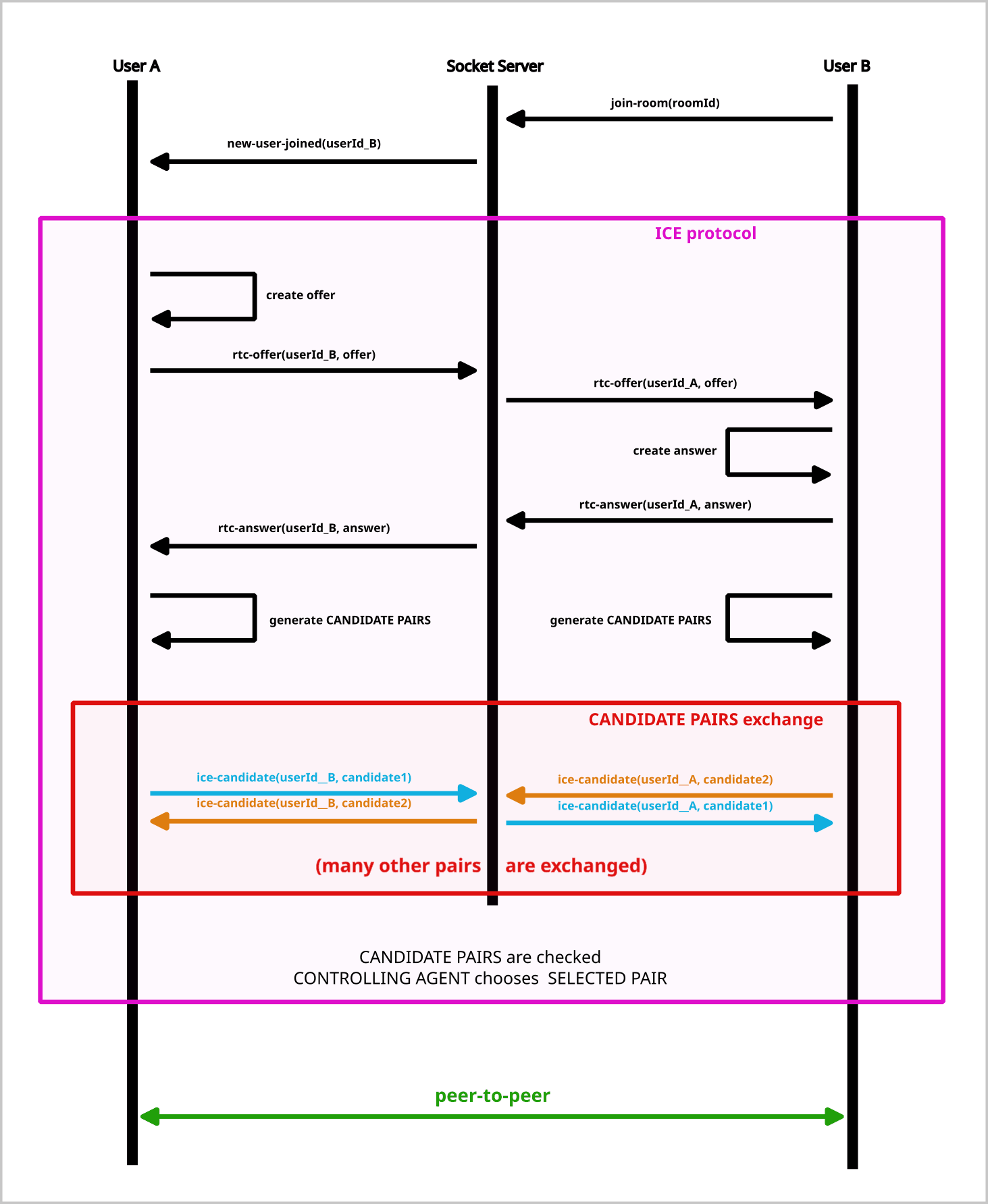
It might be easier to visualize the ICE protocol flow using a diagram.
In total, we have the following socket messages:
create-roomfrom User A to the socket server.room-created(roomId)from the socket server to User A.join-room(roomId)from User B to the socket server. You might have to handle a situation where a room with such an id does not exist.new-user-joined(userId_B)from socket server to User A. It should trigger the start of the ICE process.rtc-offer(userId_B, offer)from User A to socket server. Forwarded to User B asrtc-offer(userId_A, offer).rtc-answer(userId_A, answer)from User B to the socket server. Forwarded to User A asrtc-answer(userId_B, offer).ice-candidate(userId_<otherPeer>, candidate)from one of the users. Forwarded to the other peer asice-candidate(userId_<originalPeer>, candidate).
This simple example focuses only on 2 users. If there are more, you will have to create separate peer-to-peer connections between all of them. Each such connection requires an individual ICE process. The cause is simple - different connection conditions can exist between each 2 peers. E.g. half of the users can be in the same local network (HOST CANDIDATE), while the rest join remotely from their homes (SERVER REFLEXIVE CANDIDATES with STUN, or RELAYED CANDIDATES for TURN servers).
Many ICE candidates
After you set the icecandidate event handler, you will receive a lot of valid candidates. Each generated, non-null value should be exchanged with the other peer. An empty string acts as an end-of-candidates notification. It should also be exchanged. You can add a handler for the icegatheringstatechange event if you are interested in the current state.
WebRTC-p2p-text-chat displays each ICE candidate to the user. Often this takes half of the visible chat space.
Coding WebRTC using JavaScript
Let’s code this process in JavaScript. I will focus on the browser part, as the server side is a simple socket message forwarding. The full app can be found on GitHub: WebRTC-p2p-text-chat. I will use a socket to denote a Socket.IO connection to the socket server.
Establishing the WebRTC connection
First, we declare ICE server address constants (URLs for STUN and TURN servers). It will be then provided to the RTCPeerConnection constructor.
const ICE_SERVERS = {iceServers: [{ urls: ['stun:openrelay.metered.ca:80', 'stun:stun.l.google.com:19302'] },],};
We will also store all current p2p connections in a Map<peerId, RTCPeerConnection>. The main use case of the app is to send some data to each peer. So, naturally, you need to store the list of all peers somewhere. It also simplifies later code.
// Map<peerId, RTCPeerConnection>const peerConnectionsRepo = new Map();
Let’s also declare a utility function to create a new RTCPeerConnection that automatically registers it in peerConnectionsRepo:
const createPeerConnection = (socket, peerId) => {const peerConnection = new RTCPeerConnection(ICE_SERVERS);peerConnectionsRepo.set(peerId, peerConnection);peerConnection.onicecandidate = (event) => {if (event.candidate !== null) {socket.emit('ice-candidate', peerId, event.candidate);}};return peerConnection;};
We are now ready to execute the ICE flow. Receiving the "new-user-joined" event, User A will send an ICE offer. In response, User B will send the ICE answer. Once User A calls RTCPeerConnection: setRemoteDescription, CANDIDATE PAIRS will be tested. For each candidate, the peer emits an "ice-candidate" socket event (see utility function above). The other peer will receive it and call RTCPeerConnection: addIceCandidate.
/** (ICE step 1, executed by "User A")* A new user joined the chat room. Establish a p2p connection with them (send ICE offer)*/socket.on('new-user-joined', async (newUserId) => {const peerConnection = createPeerConnection(socket, newUserId);const channel = peerConnection.createDataChannel('my-rtc-chat'); // TODO add handlers etc.const offer = await peerConnection.createOffer();peerConnection.setLocalDescription(offer);socket.emit('rtc-offer', newUserId, offer);});/** (ICE step 2, executed by "User B")* After we join a room we will receive ICE offers. Respond with an ICE answer*/socket.on('rtc-offer', async (offerUserId, offer) => {const peerConnection = createPeerConnection(socket, offerUserId);peerConnection.setRemoteDescription(offer);peerConnection.ondatachannel = (event) => {const channel = event.channel; // TODO add handlers etc.};const answer = await peerConnection.createAnswer();peerConnection.setLocalDescription(answer);socket.emit('rtc-answer', offerUserId, answer);});/** (ICE step 3, executed by "User A")* Handle answer response to our offer. After this,* ICE can start testing CANDIDATE PAIRS*/socket.on('rtc-answer', async (answerUserId, answer) => {const connection = peerConnectionsRepo.get(answerUserId);connection.setRemoteDescription(answer);});/** (ICE step 5, executed by both "User A" and "User B")* In 'createPeerConnection' util we added a handler to 'icecandidate'.* It (ICE step 4) emits an "ice-candidate" socket message.** In the handler we just need to call "addIceCandidate" to signal ICE* that a possible transport method was found.*/socket.on('ice-candidate', async (peerUserId, candidate) => {const connection = peerConnectionsRepo.get(peerUserId);await connection.addIceCandidate(candidate);});
You can add a handler to RTCPeerConnection: connectionstatechange event to detect when the connection changes state to "connected". RTCDataChannel open event also works. In the code above, there are 2 channel variables representing the RTCDataChannel object. It is used like so:
channel.onopen = (_event) => {channel.send("Hi!");};channel.onmessage = (event) => console.log(event.data);channel.onclose = () => {console.log("RTCDataChannel closed")};// trigger send message from the UIdocument.getElementById("magic-btn").onclick = () => {channel.send("My user has clicked the button! Click it too!");}
Closing the WebRTC connection
Peer-to-peer connection is closed once the user refreshes or closes the tab. You can also close it using RTCPeerConnection: close. You should delete the RTCPeerConnection object just in case.
The other peer can detect this event by:
- Listening for RTCPeerConnection: connectionstatechange to
disconnected. For some reason, this does not always happen on Firefox. - Listening for RTCDataChannel: close event. In my experience, this is more reliable than
connectionstatechange. - Receiving the message from the socket server. If the user refreshes/closes the tab, its socket connection will reset too. Broadcast it to the entire chat room. This way you are less dependent on the whims of the browser API.
Things to watch for
You would assume that writing the correct ICE flow is complicated. Fortunately, the browsers handle it for us. The bigger problem is code readability. All the events might seem arcane to developers not familiar with the ICE protocol. To prevent this, you can e.g. make the event names more readable like socket.on('received-ice-answer, ...). Or, add comments for each step. I often slap a “preamble” comment at the top of the file with useful notes. It also contains links to tickets that reported related bugs. This makes it easier to prevent regressions. And testing p2p is not trivial in itself.
The other problem is idempotency/state management. As we have discussed above, there are usually at least 3 ways to detect that the user has disconnected. Yet you should inform the user about this only once. Sometimes you should ignore such events. In the p2p video chat app, it’s OK if the user turns off their camera or microphone.
The deployment and testing process depends a lot on our app. It differs if you use CPaaS or deploy your own. It would be a separate article in itself to describe it.

A little joke left by Firefox developers.
References
- https://bloggeek.me/webrtcglossary/
- https://webrtc.github.io/samples/
- https://www.stackfive.io/work/webrtc/the-beginners-guide-to-understanding-webrtc
- https://webrtc.github.io/samples/src/content/peerconnection/trickle-ice/
- https://www.viagenie.ca/publications/2008-08-cluecon-stun-turn-ice.pdf
- https://stackoverflow.com/questions/21069983/what-are-ice-candidates-and-how-do-the-peer-connection-choose-between-them
- https://developer.mozilla.org/en-US/docs/Web/API/WebRTC_API/Connectivity
- https://www.3cx.com/blog/voip-howto/stun-details/
- https://stackoverflow.com/questions/52581525/what-does-sdparta-stand-for-in-a-firefox-webrtc-session-description